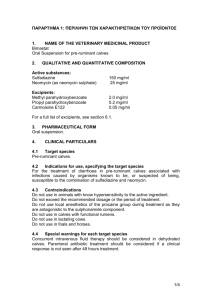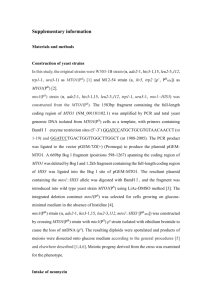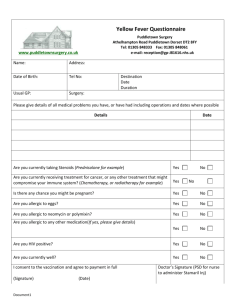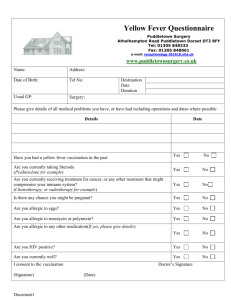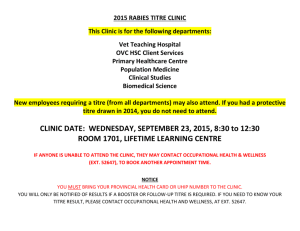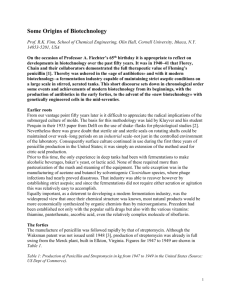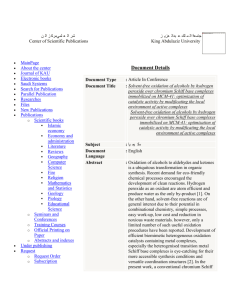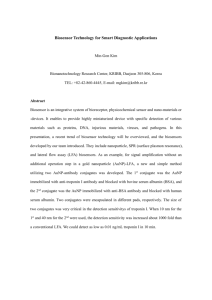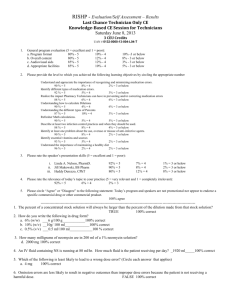production of neomycin using immobilized cells of streptomyces
advertisement
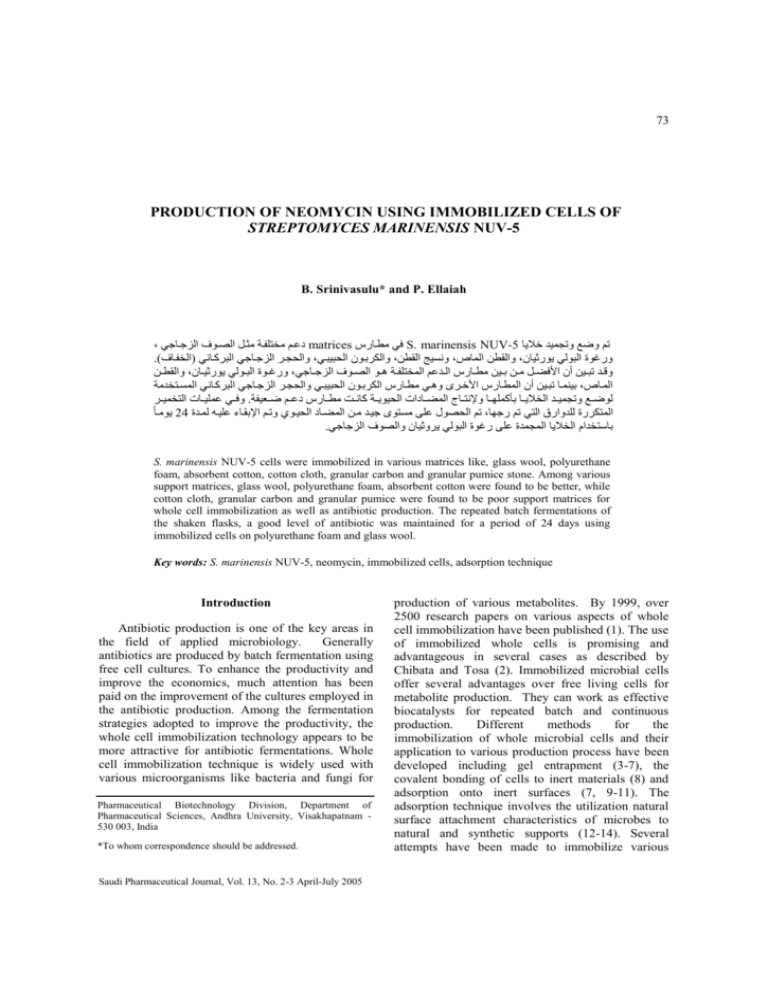
73 PRODUCTION OF NEOMYCIN USING IMMOBILIZED CELLS OF STREPTOMYCES MARINENSIS NUV-5 B. Srinivasulu* and P. Ellaiah دعام متلفةام م ال وف الز وفي اا يmatrices في مطااسS. marinensis NUV-5 تم وضع وتجميد خاليا وسغلة وفبلفي يلسثيان ووفقطن وفماص ونسيج وفقطن ووفكربالن وفببيباي ووفبجار وفي اا ي وفبر ااني اوفتةااز وقااد تبااين ألن و فناال ماان بااين مطاااس وفاادعم وفمتلفةاام اال وف االز وفي ااا ي وسغاالة وفباالفي يلسثيااان ووفقطاان وفمااص بيمماا تباين ألن وفمطااس و خاارم و اي مطااس وفكربالن وفببيبااي ووفبجار وفي اا ي وفبر ااني وفمساالتدمم فلضااع وتجميااد وفتاليااا ب مفتااا ومنلااا وفمنااادون وفبيلياام انااة مطاااس دعاام ضااييةم وفااي عمفيااان وفلتمياار يلماا24 وفملكرسة ففدووسق وفلي تم س تا تم وفب لل عفى مسللم ياد مان وفمنااد وفبيالم وتام ومبقاا عفيا فمادة باسلتدوم وفتاليا وفمجمدة عفى سغلة وفبلفي يروثيان ووف لز وفي ا ي S. marinensis NUV-5 cells were immobilized in various matrices like, glass wool, polyurethane foam, absorbent cotton, cotton cloth, granular carbon and granular pumice stone. Among various support matrices, glass wool, polyurethane foam, absorbent cotton were found to be better, while cotton cloth, granular carbon and granular pumice were found to be poor support matrices for whole cell immobilization as well as antibiotic production. The repeated batch fermentations of the shaken flasks, a good level of antibiotic was maintained for a period of 24 days using immobilized cells on polyurethane foam and glass wool. Key words: S. marinensis NUV-5, neomycin, immobilized cells, adsorption technique Introduction Antibiotic production is one of the key areas in the field of applied microbiology. Generally antibiotics are produced by batch fermentation using free cell cultures. To enhance the productivity and improve the economics, much attention has been paid on the improvement of the cultures employed in the antibiotic production. Among the fermentation strategies adopted to improve the productivity, the whole cell immobilization technology appears to be more attractive for antibiotic fermentations. Whole cell immobilization technique is widely used with various microorganisms like bacteria and fungi for Pharmaceutical Biotechnology Division, Department of Pharmaceutical Sciences, Andhra University, Visakhapatnam 530 003, India *To whom correspondence should be addressed. Saudi Pharmaceutical Journal, Vol. 13, No. 2-3 April-July 2005 production of various metabolites. By 1999, over 2500 research papers on various aspects of whole cell immobilization have been published (1). The use of immobilized whole cells is promising and advantageous in several cases as described by Chibata and Tosa (2). Immobilized microbial cells offer several advantages over free living cells for metabolite production. They can work as effective biocatalysts for repeated batch and continuous production. Different methods for the immobilization of whole microbial cells and their application to various production process have been developed including gel entrapment (3-7), the covalent bonding of cells to inert materials (8) and adsorption onto inert surfaces (7, 9-11). The adsorption technique involves the utilization natural surface attachment characteristics of microbes to natural and synthetic supports (12-14). Several attempts have been made to immobilize various 74 SRINIVASULU & ELLAIAH microbial cells for different antibiotics production, such as: penicillin (15-18), cephalosporin C (19), cephamycin (20), oxytetracycline (21, 22), rifamycin (23), bacitracin (24, 25), nikkomycin (26), neomycin (27), patulin (28, 29), erythromycin (30) and other antibiotics (31). Neomycin is one of the important aminoglycoside antibiotics widely used in pharmaceutical preparations for local applications. Also it has wide applications in veterinary practice, used in the storage tanks of petroleum fuels and in rubber tree plantations to prevent the bacterial infection of tapping wounds (32). Many workers have studied the factors and chemical composition of the media favoring the fermentation of neomycin by batch (3335) and continuous process (36) by free cells. Some studies used S. marinensis for neomycin production by solid state fermentation process (35, 37). It was reported by Park et al., (27) that the increased neomycin titre was achieved by partial immobilization of S. fradiae cells. However, the neomycin production using immobilized whole cells of Streptomyces marinensis was not reported so far. Here, we attempted to study the production of neomycin by immobilization of Streptomyces marinensis cells employing adsorption technique. The objective of this study is to investigate a simple method for the direct binding of microbial cells to a water insoluble carrier for the production of neomycin. Materials and Methods Materials: All chemicals and medium constituents used in this study were procured from Hi-Media, Mumbai, India. The support inert materials; absorbent cotton, cotton cloth and polyurethane sponge procured from Local market, while glass wool from SD Fine Chemical Ltd., India, granular carbon from BDH Limited, Poole, England and granular pumice stone from Merck KgaA, Darmstadt, Germany. Microorganisms: A mutant strain of S. marinensis NUV 5, producer of neomycin was used in the present study. It was isolated from seawater of Bay of Bengal, in the Department of Pharmaceutical Sciences, Andhra University, Visakhapatnam, India (37). It was maintained on jowar starch agar slants at 4C and Saudi Pharmaceutical Journal, Vol. 13, No. 2-3 April-July 2005 subcultured every 4 weeks. A test organism, Staphylococcus epedermidis NCIM 2493 was used for the microbiological assay of neomycin. Culture media: Slant medium (38) composition(g/L): Jowar starch, 20; corn steep liquor, 5.0; ammonium sulphate, 5.0; sodium chloride, 5.0; calcium carbonate, 5.0; and agar-agar, 20; pH 6.5. The composition of the inoculum medium is (g/L): soluble starch, 25; corn steep liquor, 10; ammonium sulphate, 5; Na Cl, 5; Ca CO3, 5 with pH 7.5. The composition of fermentation medium is (g/L): maltose, 40; sodium glutamate, 12; Dipotassium hydrogen phosphate, 0.1; magnesium sulphate, 0.5; zinc sulphate, 0.005; ferrous sulphate, 0.005; calcium chloride 0.04; and pH 8.0. pH was adjusted with 1N NaOH. Inoculum: The organism was grown on jowar starch agar slants at 30C for 7 days for complete sporulation. Five ml of sterile water was added to the slant and the spores were scraped and transferred into 250-ml Erlenmeyer flask containing 50 ml of inoculum medium. The flasks were incubated at 30C in shaker incubator (at 220 rpm) for 48 h. The cells were harvested, washed with sterile saline solution and resuspended in 25 ml sterile saline solution. This cell suspension was used as inoculum for immobilization as well as for free cell fermentations. Preparation of supporting matrices for adsorption technique: Glass wool was treated with concentrated nitric acid for 3 h and washed with distilled water (13). Polyurethane foam was washed thoroughly with distilled water (9, 39). Cotton cloth was cut into small pieces (0.5 cm2), washed with distilled water to remove the soluble chemicals that may be present in the cloth and then squeezed to remove the absorbed water (40). A thin layer of absorbent cotton was cut into 0.5 cm2 pieces, washed with distilled water and squeezed to remove the absorbed water (10). Carbon granules (0.85 to 1.7 mm) and pumice stone (granular particle size 0.8 - 3.0 mm) were washed with distilled water. Matrices were added to production medium at final concentration of 2% (w/v) and sterilized by autoclaving. PRODUCTION OF NEOMYCIN USING IMMOBILIZED CELLS Immobilization of microbial cells using support materials: The support material (2% w/v) was added into 250-ml Erlenmeyer flasks containing 45 ml fermentation medium. After sterilization, the flasks were left for 2 hours on a rotary shaker to form thin, layer of fiber network in case of glass wool and absorbent cotton (13). Microbial cells (5 ml equivalent to 0.03 g DW) were added as inoculum to the flask and left on rotary shaker for the production of neomycin. medium was aseptically decanted from each flask (at every 96 h) and the support matrix with immobilized cells was washed twice with 50-ml sterile saline solution. Then a fresh medium of the same composition (50 ml/flask) was added to each flask and the fermentation was continued for next cycle. Further batches were run at every 96 h intervals. The above process was repeated for 7 batches. The cell leakage and antibiotic titres were determined. Analytical methods: The neomycin content was quantitatively determined by microbiological assay using Staphylococcus epedermidis NCIM 2493 as test organism (41, 42). The standard neomycin sulfate (Shanghai Pharmaceutical Industry Corporation, China) was used to construct the calibration curve. The free cells and cells leaked from the support matrix were collected by centrifugation at 3000 rpm for 10 min and dried at 1050C for 3 h. The initial weight of each support matrix was determined by drying specified quantity at 105C to a constant weight. The support matrices with cells were carefully washed with distilled water, transferred into watch glasses and dried at 105°C. The difference between the weights of the support matrices before and after cell adsorption is considered to be the weight of adsorbed cells (13). Polyurethane foam was dried at 85°C (43). Fermentations: Batch fermentation with immobilized cells and free cells: Five ml of inoculum (equivalent to 0.03 g DW) of S. marinensis NUV-5 was added separately to 45 ml of fermentation medium containing 2% (w/v) of supporting matrix. The free cell fermentation was carried out by adding inoculum to 45 ml of fermentation medium without supporting matrix. The flasks were incubated at 30C on a rotary shaker (140 rpm) for 144 h, in case of immobilized cells, and for 168 h in case of free cells fermentation. A set of seven EM flasks were employed in triplicate and one flask was used every 24 h for the determination of antibiotic content, pH and the amount of free and adsorbed cells. 8000 600 6000 14 10 200 0 4000 8 Neomycin titre Cell mass Sp. neomycin conc. pH 2000 6 2 24 48 72 96 120 144 168 Time (h) Fig. 1: Time course of pH, cell mass and neomycin production by free cell culture of S. marinensis NUV-5 Saudi Pharmaceutical Journal, Vol. 13, No. 2-3 April-July 2005 8 4 0 0 9 pH 400 10 Cell mass (g/L) 12 Neomycin titre (mg/L) Specific neomycin conc.(mg/g cell mass) Repeated batch fermentation: In repeated batch fermentations, the fermentation 800 75 7 SRINIVASULU & ELLAIAH 400 200 12 Neomycin titre Adsorbed cell mass Unadsorbed cell mass Sp. neomycin conc. pH 6000 12 10 8 4000 6 4 11 Cell mass (g/L) 600 8000 Neomycin titre (mg/L) Specific neomycin conc.(mg/g cell mass) 800 9 2000 8 2 0 10 pH 76 0 0 0 24 48 72 96 120 7 144 Time (h) Fig. 2: Time course of pH, cell mass and neomycin production by immobilized cell culture of S. marinensis NUV-5 on glass wool 200 6000 12 10 8 4000 6 4 11 9 2000 8 2 0 10 pH 400 12 Neomycin titre Adsorbed cell mass Unadsorbed cell mass Sp. neomycin conc. pH Cell mass (g/L) 600 8000 Neomycin titre (mg/L) Specific neomycin conc.(mg/g cell mass) 800 0 0 0 24 48 72 96 120 7 144 Time (h) Fig. 3: Time course of pH, cell mass and neomycin production by immobilized cell culture of S. marinensis NUV-5 on polyurethane foam 200 6000 10 8 4000 6 4 11 10 9 2000 2 0 12 pH 400 12 Neomycin titre Adsorbed cell mass Unadsorbed cell mass Sp. neomycin conc. pH Cell mass (g/L) 600 8000 Neomycin titre (mg/L) Specific neomycin conc.(mg/g cell mass) 800 0 0 0 24 48 72 96 120 144 Time (h) Fig. 4: Time course of pH, cell mass and neomycin production by immobilized cell culture of S. marinensis NUV-5 on cotton cloth Saudi Pharmaceutical Journal, Vol. 13, No. 2-3 April-July 2005 8 7 PRODUCTION OF NEOMYCIN USING IMMOBILIZED CELLS 200 6000 12 10 8 4000 11 6 4 10 pH 400 12 Neomycin titre Adsorbed cell mass Unadsorbed cell mass Sp. neomycin conc. pH Cell mass (g/L) 600 8000 Neomycin titre (mg/L) Specific neomycin conc.(mg/g cell mass) 800 77 9 2000 8 2 0 0 0 0 24 48 72 96 120 7 144 Time (h) Fig. 5: Time course of pH, cell mass and neomycin production by immobilized cell culture of S. marinensis NUV-5 on absorbent cotton 400 200 6000 12 10 8 4000 6 4 11 Cell mass (g/L) 600 12 Neomycin titre Adsorbed cell mass Unadsorbed cell mass Sp. neomycin conc. pH 9 2000 8 2 0 10 pH 8000 Neomycin titre (mg/L) Specific neomycin conc.(mg/g cell mass) 800 0 0 0 24 48 72 96 120 7 144 Time (h) Fig. 6: Time course of pH, cell mass and neomycin production by immobilized cell culture of S. marinensis NUV-5 on granular carbon 200 6000 10 8 4000 6 4 11 10 9 2000 2 0 12 pH 400 12 Neomycin titre Adsorbed cell mass Unadsorbed cell mass Sp. neomycin conc. pH Cell mass (g/L) 600 8000 Neomycin titre (mg/L) Specific neomycin conc.(mg/g cell mass) 800 0 0 0 24 48 72 96 120 144 Time (h) Fig. 7: Time course of pH, cell mass and neomycin production by immobilized cell culture of S. marinensis NUV-5 on granular pumice Saudi Pharmaceutical Journal, Vol. 13, No. 2-3 April-July 2005 8 7 78 SRINIVASULU & ELLAIAH Table 1: Comparative statement of cell mass and neomycin production by free and immobilized cells of S. marinensis NUV-5 cells after 96 h of fermentation. Support Glass wool Polyurethane foam Cotton cloth Absorbent cotton Granular carbon Granular pumice stone Free cells Immobilized cell mass (g/L) 7.29 7.05 3.86 6.42 0.97 0.87 --- Free cell mass (g/L) Neomycin titre (mg/L) 1.94 2.18 5.39 2.91 5.13 6.11 11.87 6458 6462 5928 6382 5542 2997 7315 Specific neomycin concentration (mg/g DCW) 699.57 699.88 640.52 684.03 684.45 428.93 616.25 Percent of cell mass entrapped 79.03 76.37 41.71 68.85 11.92 12.5 --- Table 2: Neomycin production and cell leakage by repeated batch culture using immobilized cells of S. marinensis NUV-5 Cycle No. 1 2 3 4 5 6 7 Glass wool Neomycin titre (mg/L) 6458 7422 7495 7374 7117 6221 4265 Poly urethane foam Cell leakage (g/L) 2.03 2.24 2.79 3.65 4.24 4.36 4.54 Neomycin titre (mg/L) 6462 7280 7564 7684 7280 6125 4083 Cell leakage (g/L) 2.18 2.27 2.70 2.54 3.28 3.74 3.95 Cotton cloth Neomycin titre (mg/L) 5928 6025 5734 4290 Absorbent cotton Cell leakage (g/L) 5.36 5.53 6.15 6.43 Neomycin titre (mg/L) 6382 7350 7586 7280 6134 4375 Cell leakage (g/L) 2.91 3.21 3.27 3.62 4.34 4.69 Washed free cells Neomycin titre (mg/L) 4557 3672 2843 1294 Table 3: Comparison of neomycin production with immobilized cells on various support matrices by repeated batch cultures. Support matrix Glass wool Polyurethane foam Absorbent cotton Cotton cloth Free cells (Washed cells) Free cells (conventional) Fermentatio n time for batch (d) Medium volume (ml) Total fermentation time (d) 4 4 4 4 4 6 50 50 50 50 50 50 24 24 24 16 16 6 Results and Discussion Studies were carried out to investigate the growth and antibiotic production profiles of free and immobilized cells of S. marinensis NUV-5 on various support matrices, such as glass wool, polyurethane foam, cotton cloth, absorbent cotton, granular carbon and granular pumice stone. Saudi Pharmaceutical Journal, Vol. 13, No. 2-3 April-July 2005 Total neomycin production (mg/L) 42086 42395 39107 21977 12366 7315 specific volumetric productivity (mg/L/h) 73.06 73.60 67.89 57.23 32.20 50.79 Growth, neomycin production and pH were followed for cell free culture (Fig.1) and immobilized cells with different support matrices are presented in Fig. 2-7. For glass wool, gradual increase in cell mass was observed up to 96 h after which there was no appreciable change while with free cell fermentation (Fig. 1) the gradual cell growth was observed up to PRODUCTION OF NEOMYCIN USING IMMOBILIZED CELLS 120 h. Slight changes in pH values were observed ranging from 8.42 to 9.02. The antibiotic production started at 24 h of fermentation with immobilized cells on glass wool and reached a maximum level (6450 mg/L) by 96 h. On further incubation, no improvement in antibiotic titre was observed. In case of free cell fermentation, the maximum antibiotic production (7315 mg/L) was observed by 144 h (Fig.1). The specific antibiotic productivity of free cells (616 mg/g) is less compared with immobilized cells (699 mg/g). Further it is observed that the fermentation time with immobilized cells was reduced by 2 days over the free cells. The growth and neomycin production profiles with immobilized cells on polyurethane foam are shown in Figure 3. The results indicated a gradual increase in cell mass and antibiotic titre up to 96 h. Further incubation resulted in negligible change in cell mass and antibiotic yield. The maximum antibiotic yield with immobilized cells on polyurethane foam was 6462 g/L at 96 h and the neomycin titre was similar to the immobilized cells on glass wool. The growth and neomycin production with immobilized cells on cotton cloth are shown in Figure 4. From the data, it is evident that cell mass and neomycin titre/specific neomycin concentration increased gradually from 24 h to 120 h. Further incubation did not show increase in antibiotic titre. It was observed that the antibiotic production with the immobilized cells on cotton cloth (5928 mg/L) was slightly less than the glass wool (6458 mg/L) and polyurethane foam (6462 mg/L). The cell growth and neomycin production aspects with immobilized cells of S. marinensis on absorbent cotton are shown in Figure 5. The results showed that maximum titre (6382 mg/L) as well as maximum specific neomycin concentration was achieved at 96 h. The cell growth and neomycin production profiles with immobilized cells on granular carbon are shown in Figure 6. From the data it was found that the maximum neomycin titre was observed at 96 h (5542 mg/L). The immobilized cells on granular carbon showed less antibiotic titre when compared to the previously studied support matrices. The results of cell growth and neomycin production pattern with immobilized cells on granular pumice are shown in Figure 7. Compared with other matrices, the neomycin titre (2997 mg/L) Saudi Pharmaceutical Journal, Vol. 13, No. 2-3 April-July 2005 79 as well as cell mass (6.987 g/L) value is low. This may be due to poor adsorption of cells on granular pumice stone, which is evidenced by less cell mass production. With all the matrices, the maximum cell growth was noticed at 96 h while little changes in pH were observed during the fermentation. A comparison of the neomycin titre and cell mass production with immobilized cells on various support matrices during 96 h fermentation cycle is shown in Table 1. The amount of cell mass was varied (from 6.995 to 9.33 g/L) with the type of support matrix used. This variation may be due to the surface properties of support matrices since the attachment of microorganism may occur as a result of physicochemical interaction between the cell wall and the surface of the support matrix (36, 44). Further, the maximum percentage of cell mass adsorption onto glass wool, polyurethane foam, cotton cloth and absorbent cotton may be due to the formation of network by the matrices, whereas the network may not form with granular carbon and granular pumice. Except for granular pumice, the specific antibiotic concentration with immobilized cells was found to be superior compared with the free cells. However, with the lower cell growth of S. marinensis, the specific antibiotic concentration with the immobilized culture was more than the free cells. This can be explained by the stability of the intracellular biosynthetic factors and activities of the secondary metabolic enzymes of immobilized cells, as reported by other investigators (2, 21). Hence, the matrices such as glass wool, polyurethane foam, absorbent cotton and cotton cloths were selected for repeated batch fermentation. Granular carbon and granular pumice were found to have poor cell mass adsorption capacity and were not selected for further studies. Repeated batch fermentation with immobilized cells on various selected support matrices (glass wool, polyurethane foam, absorbent cotton and cotton cloth) was carried out to evaluate neomycin production and the longevity of the biocatalysts. The results of repeated batch fermentation with various support matrices are given in Tables 2. From the results (Table 2), it was observed that the cells immobilized on glass wool, polyurethane foam and absorbent cotton continued to produce significant neomycin titres for 24 days (6 batches) and on further incubation decrease in antibiotic titre was observed, whereas the cells immobilized on 80 cotton cloth was able to produce the antibiotic for 16 days only. An increased cell leakage was observed with repeated batch fermentations with all the matrices. Repeated batch fermentation for neomycin production was carried out with washed free cells and the results are represented in table 2. The data indicates decrease in neomycin titre with increase of cycle number. A comparative data on the total antibiotic produced with free cells and immobilized cells (on glass wool, polyurethane foam, absorbent cotton and cotton cloth) for 24 days are shown in Table 3. The data shows that the average specific volumetric productivity with glass wool and polyurethane foam matrices was around 73.60 mg/L/h, which account for about 44% more production over the free cell fermentation (50.79 mg/L/h). Similarly, the antibiotic productivity was 33.6% and 12.6% higher with absorbent cotton, cotton cloth respectively compared with free cell fermentation. From the data it is clear that immobilized cells of S. marinensis are more efficient for the production of neomycin in repeated shake flask process. Similar observations were reported by Farid et al., (21) where the immobilized growing cells on glass wool continued to produce oxytetracycline by Streptomyces and rifamycin B & SV by Amycolaptosis for 20 days. Similarly, Investigators studied on cells immobilizing by adsorption technique on various support matrices for different antibiotics production and reported the antibiotic yields are high compared with free cell fermentations (9, 18, 40, 43). The immobilization of S. marinensis cells by entrapment in various matrices (calcium alginate, poyacrylamide, gelatin and agar-agar) were also studied and concluded that the immobilized cells on support matrices were superior compared to immobilized cells by entrapment. The data was reported elsewhere (35). Among various support matrices, glass wool, polyurethane foam, absorbent cotton were found to be good, while cotton cloth, granular carbon and granular pumice were found to be poor support matrices for whole cell immobilization as well as antibiotic production. Although, absorbent cotton is good matrix, it is compressible, and can’t withstand high shear in the reactors, whereas the immobilized cells on polyurethane foam and glass wool had some merit. Apart from its good antibiotic production in repeated batch fermentation for 24 days, it has the Saudi Pharmaceutical Journal, Vol. 13, No. 2-3 April-July 2005 SRINIVASULU & ELLAIAH resistance to the higher shear in the reactors, stability under the sterilization conditions and low raw material cost. The superior nature of polyurethane foam for whole cell immobilization is also reported by several investigators (7, 10, 11) for the production of various metabolites. Acknowledgements The authors would like to acknowledge University Grants Commission, Government of India, for providing fellowship to Mr. B. Srinivasulu to carry out this work. References 1. 2. 3. 4. 5. 6. 7. 8. 9. 10. 11. 12. 13. 14. Ramakrishna SV, Prakasham RS. Microbial fermentation with immobilized cells. Curr Sci, 1999; 77: 87-100. Chibata I., Tosa T. Use of immobilized cells. Ann. Rev. Biophys Bioengg, 1981; 10: 197-216. Laudrain I, Goma G. Ethanol production by Zymomonas mobilis: Effect of temperature on cell growth, ethanol production and intracellular ethanol acculation, Biotechnol Lett, 1982; 4: 537-542. Williams D, Munnecke DM. The production of Ethanol by immobilized Yeasts of Saccharomyces cerevisiae Cells. Biotechnol Biengg. 1981; 23: 1813-1826. Guzide C, Savasu H, Calik P, Ozolamar TH. Growth and carrageenan immobilization of Pseudomonas dacunhae cells for L-alanine production. Enzy Microbiol Technol, 1999; 24: 67-74. Fukui S, Tanaka A. Immobilized Microbial Cells. Ann. Rev. Microbiol., 1982; 36: 145-172. Elibol M, Ozer D. Lipase production by immobilized Rhyzopus arrhizus, Process Biochem, 2000; 36: 219-223. Gottschal JC, Morris JG. Continuous production of acetone and butanol by Clostridium acetobutylicum growing in turbidostat culture. Biotechnol Lett, 1982; 4: 477-482. Gekas VC. Artificial membrane as carrier for the immobilization of biocatalysts, Enz Microb Technol, 1986; 8: 450-460. Devi S, Sridhar P. Production of cephamycin C in repeated batch operations from immobilized Streptomyces clavuligerus, Process Biochem, 2000; 36: 225-231. Beg QK, Bhushan B, Kapoor M, Hoondal GS, Enhanced production of thermostable xylanase from Streptomyces sp. QG-11-3 and its application in biobleaching of eucalyptus kraft pulp, Enzy Microbiol Technol, 2000; 27: 459-466. Bisping B, Baumann U, Rehm HJ. Production of glycerol by immobilized Pichia farinosa. Appl Microbiol Biotechnol, 1990; 32: 380-386. D'Souza, SF, Melo J, Deshpande A, Nadkarni GB. Immobilization of yeast cells by adhesion to glass surface using polyethylenimine. Biotechnol Lett, 1986; 8: 643-648. Mozes N, Marchal F, Hermesse MP, Van Haecht JL, Reuliaux L, Leonard AJ, Rouxhet GP. Immobilization of microorganisms by adhesion: Interplay of electrostatic and Non-electrostatic interactions. Biotechnol Bioeng, 1987; 30: 439-450. PRODUCTION OF NEOMYCIN USING IMMOBILIZED CELLS 15. Morikowa Y, Karube I, Suzuki S. Penicillin G production by immobilized whole cells of Penicillium chrysogenum, Biotechnol Bioeng, 1979; 21: 261-270. 16. Kurzatowski W, Kurylowics W, Paskiewics A. Penicillin G production by immobilized fungal vesicles. Eur J Appl Microbiol Biotechnol, 1982; 5: 211-213. 17. Sawidge T. Enzymatic conversions used in the production of penicillins and cephalosporins. In: Biotechnology of Industrial Antibiotics. EJ Vandamme, ed., Marcel Dekker, New York, 1984; p.171-224. 18. Karhoot JM, Anderson JG, Blain JA. Production of Penicillin by immobilized film of Penicillium chrysogenum, Botechnol Lett, 1987; 9: 471-474. 19. Ellaiah P, Muralichand G, Srinivasulu B, Pardhasaradhi SV. Production of cephalosporin C by immobilized cells of Cephalosporium acremonium, Ind J Expt Biol, 2000; 38: 1134. 20. Freeman A, Aharnowitz Y. β-Lactum antibiotic biosynthesis and 17-ketosteroid reduction by bacteria immobilized in cross-linked polymerized linear polyacrylamide. Proceedings of the 16th international fermentation symposium. London, Ontario, Canada, 1980; p.1211. 21. Farid MA, EL Diwany AI, EL Enshasy HA. Production of oxytetracycline and rifamycins B and SV with cells immobilized on Glass wool, Acta Biotechnol, 1994; 14: 6774. 22. Ogaki M, Sonomoto K, Nakagima H, Tanaka A. Continuous production of oxytetracycline by immobilized growing Streptomyces rimosus cells. Appl Microbiol Biotechnol, 1986; 24: 6-11. 23. Chung BH, Chang HN, Kim LH. Rifamycin B production by Nocardia mediterranei immobilized in a dual hallow fibre bioreactor. Enzyme Microb Technol, 1987; 9: 345-349. 24. Vandamme EJ. Peptide antibiotic production through immobilized biocatalyst technology. Enz Microb Technol, 1982; 5: 403-416. 25. Morikawa Y, Karube I, Suzuki S. Continuous production of bacitracin by immobilized whole cells of Bacillus sp. Biotechnol Bioeng 1980; 22: 1015-1023. 26. Veelken M, Pape H. Production of tylosin and nikkomycin by immobilized streptomyces cells. Eur J Appl Microbiol Biotechnol 1982; 15: 206-210. 27. Park YS, Ohata N, Okabe M. Neomycin production by partial immobilization of Streptomyces fradiae on cellulose beads in an airlift bioreactor. J Ferm Bioeng, 1994; 78: 265268. 28. Berk D, Behie LA, Jones A, Lesser BH, Gauther M. The production of the antibiotic patulin in a three phase fludized bed reactor. II. The longevity of the biocatalyst. Can J Chem Engg. 1984; 62: 120-124. 29. Deo YM, Costerton JW, Gaucher RM. Semicontinuous and continuous production of antibiotics by immobilized fungal Saudi Pharmaceutical Journal, Vol. 13, No. 2-3 April-July 2005 30. 31. 32. 33. 34. 35. 36. 37. 38. 39. 40. 41. 42. 43. 44. 81 cells. Developments in Industrial Microbiology. Appl Microbiol Biotechnol. 1985; 21: 220-225. Bandyopadhyay A, Das AK, Mandal SK. Erythromycin production by Streptomyces erythreus entrapped in calcium alginate beads. Biotechnol Lett, 1993; 15: 1003-1006. Egorov NS, Baranova IP, Kozlova Y. Nisin production by immobilized cells of lactic acid Bacterium lactis. Antibiotiki, 1978; 23: 872-349. Lechevalier HA. The 25 years of neomycin. CRC Critical Reviews in Microbiology. CRC Press, Florida, 1975; 3: 359397. Dulmage HT. The production of neomycin by Streptomyces fradiae in synthetic media, Appl Microbiol, 1953; 1: 103106. Mangallam S, Vashi AA, Sukapuri RS, Gopalakrishnan KS. Some factors affecting neomycin production by Strptomyce fradiae. Hindust Antibiot Bull, 1974; 17: 1-6. Srinivasulu B. Studies on Bioprocess Development with special reference to Strain improvement, Solid state fermentation and Immobilization of Streptomyces marinensis cells for the production of neomycin, Ph.D Thesis, Andhra University, India, 2002. Nelson RP, US Pat. 3957 580, 1976. Ellaiah P, Srinivasulu B, Adinarayana K. Optimization studies on neomycin production by a mutant strain of Streptomyces marinensis in solid state fermentation, Process Biochem, 2003 (In Press). Sambamurthy K, Ellaiah P. A new Streptomycete producing neomycin (B&C) complex - S. marinensis (part I), Hind Antibiot Bullet, 1974; 17: 24-27. Massiniliano F, Roberta DG, Eric R, Jean-Louis L, Fedirico F. Repeated batch and continuous production of chitinolytic enzymes by Pencillium janthinellum immobilized on chemically modified macroporous cellulose, J Biotechnol, 1998; 62: 119-131. Sushma Joshi, Hiroshi Yamzaki. Repeated batch antibiotic fermentation by Streptomyces immobilized on cotton cloth, Biotechnol Technique, 1987; 1:45-48. Grove DC, Randall WA. Assay methods of antibiotics: A laboratory manual, Medical Encyclopedia, Inc., NY, 1955,p. 91. Indian Pharmacopoeia, Vol. II, Government of India, Ministry for Health and Welfare, The Controller of Publications, New Delhi, 1996; A-100. Chetsumon A, Fujienda K, Hirata K, Yagi K, Miura M. Optimization of antibiotic production by the Cynobacterium scytonema sp. TISTR 8208 immobilized on polyurethane foam, J. Appl. Phycology, 1993; 5: 615-622. Lechevalier MP, Prauser H, Labeda DP, Ruan JS. Two new genera of Nocardia form Actinomyces: Amycolata gen.nov. and Amycolatopsis. Gen. Nov. Int J Syst Bacteriol, 1986; 36: 2937.
